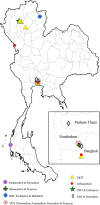Review of insecticide resistance and behavioral avoidance of vectors of human diseases in Thailand
- PMID: 24294938
- PMCID: PMC3850650
- DOI: 10.1186/1756-3305-6-280
Review of insecticide resistance and behavioral avoidance of vectors of human diseases in Thailand
Abstract
Physiological resistance and behavioral responses of mosquito vectors to insecticides are critical aspects of the chemical-based disease control equation. The complex interaction between lethal, sub-lethal and excitation/repellent ('excito-repellent') properties of chemicals is typically overlooked in vector management and control programs. The development of "physiological" resistance, metabolic and/or target site modifications, to insecticides has been well documented in many insect groups and disease vectors around the world. In Thailand, resistance in many mosquito populations has developed to all three classes of insecticidal active ingredients currently used for vector control with a majority being synthetic-derived pyrethroids. Evidence of low-grade insecticide resistance requires immediate countermeasures to mitigate further intensification and spread of the genetic mechanisms responsible for resistance. This can take the form of rotation of a different class of chemical, addition of a synergist, mixtures of chemicals or concurrent mosaic application of different classes of chemicals. From the gathered evidence, the distribution and degree of physiological resistance has been restricted in specific areas of Thailand in spite of long-term use of chemicals to control insect pests and disease vectors throughout the country. Most surprisingly, there have been no reported cases of pyrethroid resistance in anopheline populations in the country from 2000 to 2011. The precise reasons for this are unclear but we assume that behavioral avoidance to insecticides may play a significant role in reducing the selection pressure and thus occurrence and spread of insecticide resistance. The review herein provides information regarding the status of physiological resistance and behavioral avoidance of the primary mosquito vectors of human diseases to insecticides in Thailand from 2000 to 2011.
Figures






References
-
- Roberts DR, Andre RG. Insecticide resistance issues in vector-borne disease control. Am J Trop Med Hyg. 1994;50:21–34. - PubMed
-
- Reiter P, Gubler DJ. In: Dengue and dengue hemorragic fever. Gubler D, Kuno G, editor. New York: CAB International; 1997. Surveillance and control of urban dengue vectors; pp. 45–60.
-
- WHO. Prevention and control and dengue and dengue haemorrhagic fever: Comprehensive guidelines. New Delhi: World Health Organization Regional Publication; 1999.
-
- Stein G. Malaria eradication in Thailand. Bangkok, Thailand: USOM; 1970.
Publication types
MeSH terms
Substances
LinkOut - more resources
Full Text Sources
Other Literature Sources

